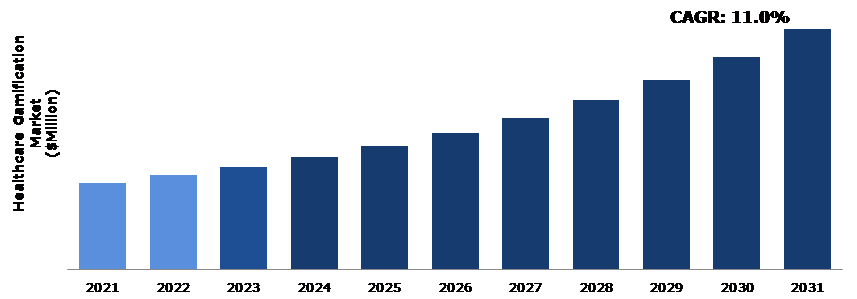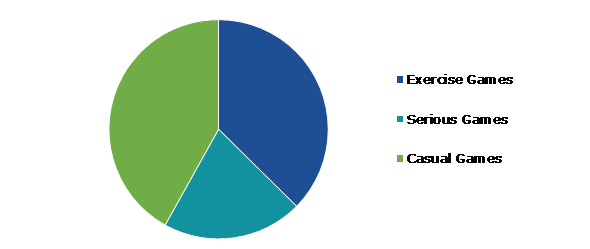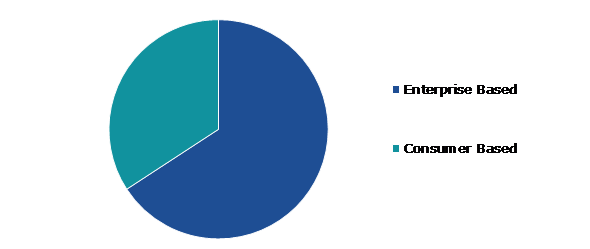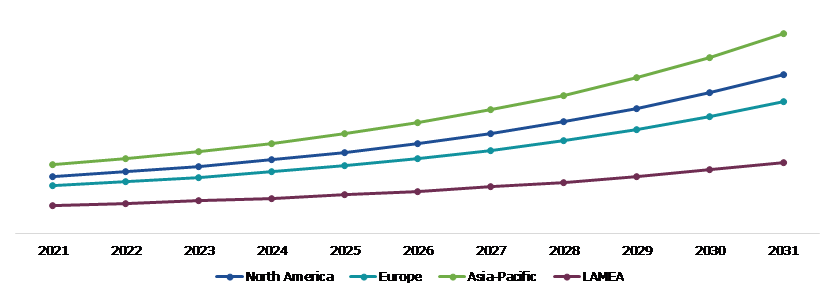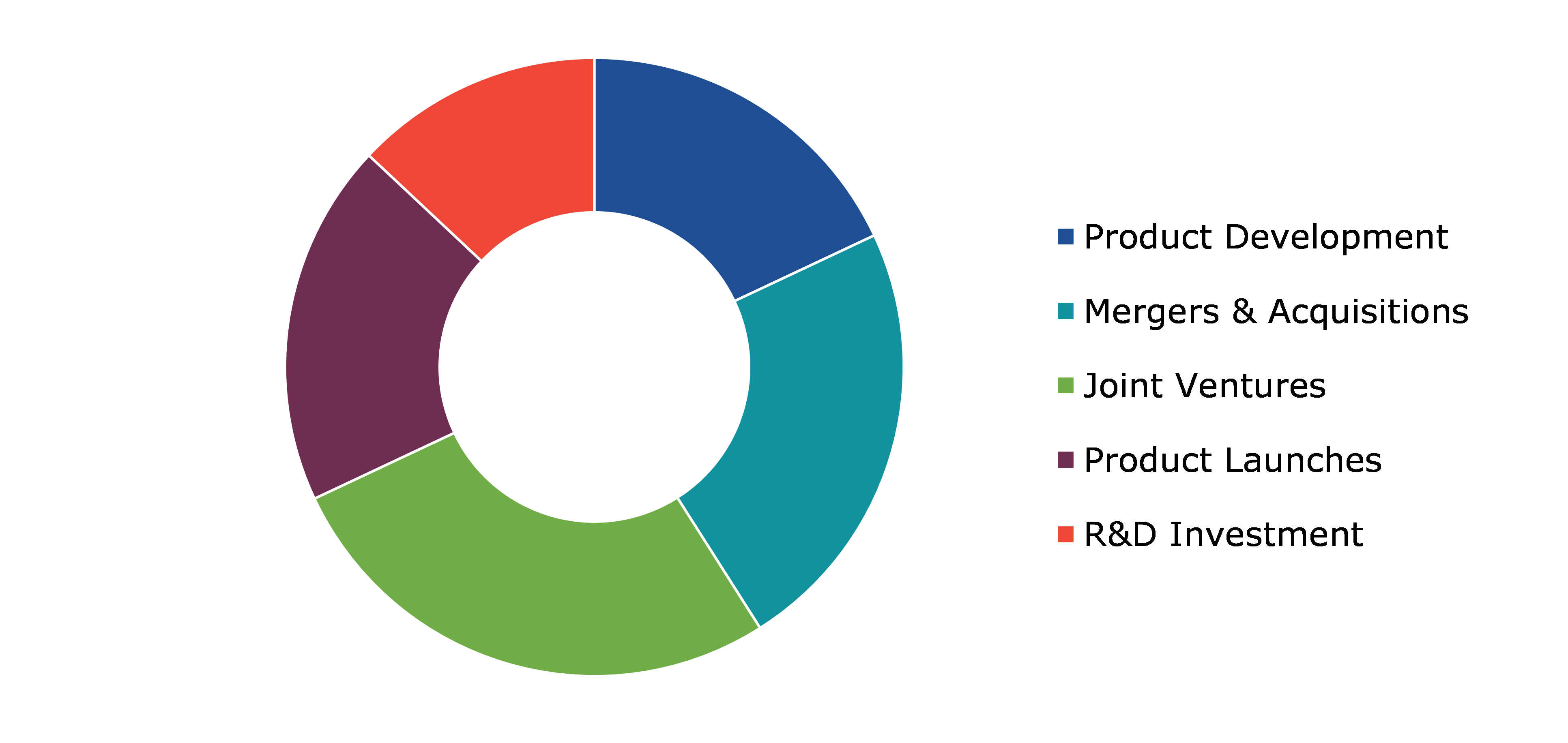Healthcare Gamification Market Report
RA00062
Healthcare Gamification Market by Game Type (Exercise Games, Serious Games, and Casual Games), Application (Education, Therapeutic, and Prevention), End Use (Consumer Based and Enterprise Based), Regional Analysis (North America, Europe, Asia-Pacific, and LAMEA), Global Opportunity Analysis and Industry Forecast, 2022–2031.
Global Healthcare Gamification Market Analysis
The global healthcare gamification market size was $ 3,260 million in 2021 and is predicted to grow with a CAGR of 11.0%, by generating a revenue of $9,040.9 million by 2031.
Global Healthcare Gamification Market Synopsis
Gamification is the process of incorporating a game or game-like element into a task to increase participation in the event. It has been shown to be effective because it taps into people's natural desire for competition and achievement. Furthermore, gamification is an important feature in designing websites and apps that can motivate people to meet personal challenges, which helps the user track the progress of their task in a more fun designing-like manner. Following extensive research, the developers implemented the use of gamification in the healthcare sector.
The adoption of wellness apps and wearables with gaming features is clear evidence that people like them. One of the major advantages of healthcare gamification is people are increasingly adopting fitness and wellness apps that are available for free; these apps allow users to communicate directly with physicians and other medical professionals, which is expected to fuel the growth of the healthcare gamification market during the forecast period. Furthermore, gamification in healthcare is being used for a variety of purposes, including medication & chronic illness management, well-being & fitness, physiotherapy, child improvement, and recovery, which is an important factor expected to boost the healthcare gamification market growth in healthcare sectors. These factors are anticipated to boost the healthcare gamification market share in the upcoming years.
Assuring proper use and adherence is potentially the biggest difficulty designers encounter when developing new items meant to improve a person's health. Although a consumer may at first adopt a product with hope or even enthusiasm, over time we frequently observe diminishing engagement and inconsistent use. When the effectiveness of the product depends on long-term use, this issue may hinder the healthcare gamification market growth.
Computer games are used in physical therapy for a variety of reasons, including their attractiveness, motivation, and level of engagement, but none of these reasons ensures that the interventions will have the desired therapeutic effect. These traits, however, are crucial elements in physical therapy interventions because they engage reward-related dopaminergic systems in the brain, which are known to promote learning through long-term potentiation of neural connections. A low-cost gizmo that motivates patients to do their exercises even when they are not being seen by their physical therapist has been made possible using gamification. A cloud-based dashboard can be used to calculate a patient's workout schedule. Thus, the market for healthcare gamification is anticipated to develop as physical therapy usage rises.
According to regional analysis, the Asia-Pacific healthcare gamification market accounted for the highest market share in 2021. This is because, in China, the use of healthcare gamification applications has increased among people with health-conscious lifestyles.
Healthcare Gamification Overview
Gamification in healthcare refers to the applications of gaming concepts, methods, and dynamics to non-game applications in an effort to enhance clinical outcomes. Gamification in health software benefits users and medical professionals alike. Healthcare providers engage consumers and raise their satisfaction with the app and the company as a whole, while users enjoy their experience with an application. In turn, this encourages user growth and client loyalty.
COVID-19 Impact on Global Healthcare Gamification Market
The COVID-19 pandemic created several uncertainties, resulting in significant economic losses as various businesses around the world came to a halt. Furthermore, major healthcare gamification application-producing countries such as the United States and China were subjected to import-export restrictions. Several countries, for example, imposed tariffs on Chinese imports. In addition, the import-export restrictions were laid down on major healthcare gamification application-producing countries such as the U.S. and China. For instance, goods being imported from China were imposed by several countries. In addition, the hardware & software sectors faced the highest impact in terms of sales and acquisition of new projects, due to which the healthcare gamification applications demand reduced significantly.
The worldwide healthcare gamification market has been given new chances as a result of the COVID-19 outbreak. People were forced to work from home when the pandemic was announced and worldwide lockdowns were implemented, which had an adverse effect on their physical and emotional health. They tried to break the unhealthy pattern as soon as they realized it. As a result of this process, the market for gamification in healthcare, including smartwatches, wellness applications, and fitness monitoring gadgets, experienced growth. In order to enhance contact, assess patients' well-being, and ultimately improve outcomes while keeping to social-distancing norms, doctors and physicians have also begun embracing gamified systems to monitor their patients' vitals. In order to deliver medical education and assure patient safety, healthcare facilities like hospitals and medical schools are also implementing a variety of gamification technologies, such as AR/VR, or mixed reality.
Adoption of Artificial Intelligence (AI) based Gamification Solutions to incentivize Market Growth
Adoption of artificial intelligence (AI)-based gamification solutions to incentivize Market Growth One of the key drivers of market growth is the rise in the adoption of gamification solutions based on the AI platform. Large hospitals are adopting AI-based solutions to attain deep insights into their patients. AI-based gamification models provide accurate solutions by eliminating the ambiguity of patients’ motives and helping patients achieve targets more efficiently. Key players in the market are focused on investing in the development of an AI-based solution. Transparency and a collaborative, engaging culture help the company to attain a competitive advantage over its competitors. Rehabilitation centers and therapy clinics are adopting AI-based solutions to streamline patient motivation, engagement, and participation. The rise in adoption of AI-based solutions would help to attain transparency and collaborative cultures, leading to market growth.
Undesired Outcome as a Result of Poor Design is likely to hamper the Adoption of the Software
Designing for gamification is a critical component of ensuring that the desired outcome is achieved. However, it has been observed, that designers fail to come up with unique and advanced designs that meet every organization's needs. This might slow the adoption of solutions on the market. Even though a solution is for a particular organization, the same solution won't be giving the expected result for other audiences, making it a complex development process. Thus, an accurately constructed design with its proper implementation is mandatory to achieve the desired outcome, if done otherwise will jeopardize the result and slow the healthcare gamification market share.
Use of healthcare gamification to empower patients’ health with the use of physiotherapy, and medical therapy to drive excellent opportunities.
Healthcare gamification instills a winning attitude among clients, empowering them to utilize the service. Patients with portability limitations, the elderly, and people experiencing back distress can profit from these gamified exercises in considerably more complex clinical settings. Additionally, this gamification in healthcare is being utilized for different purposes, including well-being and fitness, medication and chronic illness management, physiotherapy, enrichment for children, and recovery. Gamification in healthcare offers great potential in independent medicine, wellness & nutrition, physical therapy, and mental well-being.
Global Healthcare Gamification Market, by Game Type
Based on game type, the market has been divided into exercise games, serious games, and casual games. Among these, the casual game sub-segment accounted for the highest market share in 2021, whereas the serious game sub-segment is estimated to show the fastest growth during the forecast period.
Global Healthcare Gamification Market Growth, by Game Type, 2021
Source: Research Dive Analysis
The casual game sub-type is accounted for the highest market size in 2021. Leading factors are driving the demand for casual games and increasing the acceptance among youngsters, and the working population. Moreover, the increasing focus on awareness related to fitness and surrounding healthy well-being is significantly increasing the demand for casual games during the forecast period. Healthcare gamification models for casual and fitness are more cost-effective than traditional fitness models developed by traditional fitness institutes, which is propelling industrial expansion.
The serious game sub-type is anticipated to show the fastest growth during the forecast period. It also has higher market growth as compared to other segments due to wide acceptability and demand for serious games among senior citizens. Gamification in healthcare helps to change people's behavior by offering rehabilitation exercises and developing cognitive skills. However, people are engaging more in exercise and serious games, which is going to push the healthcare gamification market demand during the forecast period.
Global Healthcare Gamification Market, by Application
Based on application, the market has been divided into education, therapeutic, prevention, and others. Among these, the prevention application sub-segment accounted for the highest revenue share in 2021, whereas the therapeutic application sub-segment is estimated to show the fastest growth during the forecast period.
Global Healthcare Gamification Market Outlook, by Application, 2021
Source: Research Dive Analysis
The Preventions Application sub-type is anticipated to have a dominant market share and generate revenue in 2021 and also is anticipated to show the fastest growth during the forecast period. The healthcare industry is evolving due to digital technology and video games. The medical industry is gradually shifting to preventive healthcare and adopting digital technologies more and more to enhance overall well-being. Through the use of preventative healthcare games, gamification tools are lowering the cost, increasing the fun factor, and amplifying the impact of disease prevention programs. Preventive healthcare games are used by patients and medical professionals to track and manage prescriptions. The primary driver driving the market over the forecast period is the rising use of preventive healthcare games for disease prevention and management.
Global Healthcare Gamification Market, by End-use Industry
Based on end-use industry, the market has been divided into Consumer Based and Enterprise. Among these, the Enterprise segment accounted for fastest growing in 2031.
Global Healthcare Gamification Market Share, by End-use Industry, 2021
Source: Research Dive Analysis
The Consumer-Based sub-type accounted for the highest market size in 2021. Just like there’s no one-size-fits-all approach to prescribing medicine, there’s no one-size-fits-all approach to gamification. Therefore, an intimate familiarity with each user’s unique health goals or medication regimen will make them feel special. Setting clear goals becomes a lot easier when you personalize them. For instance, digital healthcare apps such as Noom hook their users in right away by asking them a series of personal questions. Their responses are then used to build a profile of their respective goals.
The Enterprise based sub-type is anticipated to show the fastest growth during the forecast period. The healthcare gamification market is dominated by enterprise-based solutions. End-users of this market are companies or organizations that monitor the well-being of their staff. Growing awareness of employees' general health, which has a direct impact on their productivity and efficiency, is driving this segment's rise. Customer feedback is critical for any company looking to renew existing customer services. Gamification can help a lot here. Customers and employees can both provide real-time feedback with Gamification. The leading market players are responding to this need by releasing products primarily dedicated to employee health tracking.
Global Healthcare Gamification Market, Regional Insights
The healthcare gamification market was investigated across North America, Europe, Asia-Pacific, and LAMEA.
Global Healthcare gamification Market Size & Forecast, by Region, 2021-2031 (USD Million)
Source: Research Dive Analysis
The Market for Healthcare gamification in Asia-Pacific is the Most Dominant
The Asia-Pacific healthcare gamification market outlook is projected to show the fastest growth. The market for gamification solutions has generally been more open in Asia-Pacific. Internet connectivity with several channel partners and clients has been widely used by businesses. The Asia-Pacific gamification industry is being driven by the widespread adoption of customer-based and enterprise-based solutions. Additionally, in this region, nations such as China and Japan are implementing gamification strategies to improve their marketing campaigns through improved branding, customer interaction, and advertising. Furthermore, the Rise in desire for cloud-based gamified solutions among businesses due to their low implementation costs has contributed to the healthcare gamification market growth. Currently, compared to other areas, the Asia-Pacific healthcare gamification market size is responsible for a sizable amount of revenue.
The Market for Healthcare gamification in Europe is the fastest growing
This region is the market leader in healthcare gamification and is likely to propel the market significantly higher throughout the forecast period. This is due to the region's greater technological and economic development. Furthermore, millennials and the young population are aware of healthcare and health parameters due to the increase in the rate of literacy and the rising importance of health through various social media platforms, campaigns, initiatives, and advertisements. Furthermore, the increase in the adoption of the Internet and smartphones has made it easy for healthcare information technology companies to reach consumers directly through online platforms. Such variables are propelling the healthcare gamification market trend throughout Europe.
Competitive Scenario in the Global Healthcare gamification Market
Source: Research Dive Analysis
Some of the leading players in the healthcare gamification market analysis are Nike, Ayogo Health, Fitbit, Bunchball, Microsoft, EveryMove, Hubbub Health, Akili Interactive labs, Mango Health, and JawBone.
| Aspect | Particulars |
| Historical Market Estimations | 2020-2021 |
| Base Year for Market Estimation | 2021 |
| Forecast Timeline for Market Projection | 2022-2031 |
| Geographical Scope | North America, Europe, Asia-Pacific, LAMEA |
| Segmentation by Game Type |
|
| Segmentation by Application |
|
| Segmentation by End-Use |
|
| Key Companies Profiled |
|
Q1. What is the size of the global healthcare gamification market?
A. The size of the global healthcare gamification market was over $3,260 million in 2021 and is projected to reach $ 9,040.9 million by 2031.
Q2. Which are the major companies in the healthcare gamification market?
A. Nike, Ayogo Health, and Fitbitare some of the key players in the global healthcare gamification market.
Q3. Which region, among others, possesses greater investment opportunities in the near future?
A. Asia-Pacific possesses great investment opportunities for investors to witness the most promising growth in the future.
Q4. What will be the growth rate of the Asia-Pacific healthcare gamification market?
A. Asia-Pacific healthcare gamification market is anticipated to grow at 11.4 % CAGR during the forecast period.
Q5. What are the strategies opted by the leading players in this market?
A. Collaboration and investment are the two key strategies opted for by the operating companies in this market.
Q6. Which companies are investing more on R&D practices?
A. Fitbit, Bunchball, and Microsoft are the companies that invest more in R&D activities for developing new products and technologies.
1.Research Methodology
1.1.Desk Research
1.2.Real time insights and validation
1.3.Forecast model
1.4.Assumptions and forecast parameters
1.5.Market size estimation
1.5.1.Top-down approach
1.5.2.Bottom-up approach
2.Report Scope
2.1.Market Definition
2.2.Key objectives of the study
2.3.Report Overview
2.4.Market segmentation
2.5.Overview of the impact of COVID-19 on the global healthcare gamification market
3.Executive Summary
4.Market Overview
4.1.Introduction
4.2.Growth impact forces
4.2.1.Drivers
4.2.2.Restraints
4.2.3.Opportunities
4.3.Market value chain analysis
4.3.1.List of raw material suppliers
4.3.2.List of manufacturers
4.3.3.List of distributors
4.4.Innovation & sustainability matrices
4.4.1.Technology matrix
4.4.2.Regulatory matrix
4.5.Porter’s five forces analysis
4.5.1.Bargaining power of suppliers
4.5.2.Bargaining power of consumers
4.5.3.Threat of substitutes
4.5.4.Threat of new entrants
4.5.5.Competitive rivalry intensity
4.6.PESTLE analysis
4.6.1.Political
4.6.2.Economical
4.6.3.Social
4.6.4.Technological
4.6.5.Environmental
4.7.Impact of COVID-19 on the healthcare gamification market
4.7.1.Pre-covid market scenario
4.7.2.Post-covid market scenario
5.Healthcare Gamification Market, by Game Type
5.1.Overview
5.2.Exercise Games
5.2.1.Definition, key trends, growth factors, and opportunities
5.2.2.Market size analysis, by region
5.2.3.Market share analysis, by country
5.3.Serious Games
5.3.1.Definition, key trends, growth factors, and opportunities
5.3.2.Market size analysis, by region
5.3.3.Market share analysis, by country
5.4.Casual Games
5.4.1.Definition, key trends, growth factors, and opportunities
5.4.2.Market size analysis, by region
5.4.3.Market share analysis, by country
5.5.Research Dive Exclusive Insights
5.5.1.Market attractiveness
5.5.2.Competition heatmap
6.Healthcare Gamification Market, by Application
6.1.Education
6.1.1.Definition, key trends, growth factors, and opportunities
6.1.2.Market size analysis, by region
6.1.3.Market share analysis, by country
6.2.Therapeutic
6.2.1.Definition, key trends, growth factors, and opportunities
6.2.2.Market size analysis, by region
6.2.3.Market share analysis, by country
6.3.Prevention
6.3.1.Definition, key trends, growth factors, and opportunities
6.3.2.Market size analysis, by region
6.3.3.Market share analysis, by country
6.4.Research Dive Exclusive Insights
6.4.1.Market attractiveness
6.4.2.Competition heatmap
7.Healthcare Gamification Market, by End-use
7.1.Consumer Based
7.1.1.Definition, key trends, growth factors, and opportunities
7.1.2.Market size analysis, by region
7.1.3.Market share analysis, by country
7.2.Enterprise Based
7.2.1.Definition, key trends, growth factors, and opportunities
7.2.2.Market size analysis, by region
7.2.3.Market share analysis, by country
7.3.Research Dive Exclusive Insights
7.3.1.Market attractiveness
7.3.2.Competition heatmap
8.Healthcare Gamification Market, by Region
8.1.North America
8.1.1.U.S.
8.1.1.1.Market size analysis, by Game Type, 2021-2031
8.1.1.2.Market size analysis, by Application, 2021-2031
8.1.1.3.Market size analysis, by End-use, 2021-2031
8.1.2.Canada
8.1.2.1.Market size analysis, by Game Type, 2021-2031
8.1.2.2.Market size analysis, by Application, 2021-2031
8.1.2.3.Market size analysis, by End-use, 2021-2031
8.1.3.Mexico
8.1.3.1.Market size analysis, by Game Type, 2021-2031
8.1.3.2.Market size analysis, by Application, 2021-2031
8.1.3.3.Market size analysis, by End-use, 2021-2031
8.1.4.Research Dive Exclusive Insights
8.1.4.1.Market attractiveness
8.1.4.2.Competition heatmap
8.2.Europe
8.2.1.Germany
8.2.1.1.Market size analysis, by Game Type, 2021-2031
8.2.1.2.Market size analysis, by Application, 2021-2031
8.2.1.3.Market size analysis, by End-use, 2021-2031
8.2.2.UK
8.2.2.1.Market size analysis, by Game Type, 2021-2031
8.2.2.2.Market size analysis, by Application, 2021-2031
8.2.2.3.Market size analysis, by End-use, 2021-2031
8.2.3.France
8.2.3.1.Market size analysis, by Game Type, 2021-2031
8.2.3.2.Market size analysis, by Application, 2021-2031
8.2.3.3.Market size analysis, by End-use, 2021-2031
8.2.4.Spain
8.2.4.1.Market size analysis, by Game Type, 2021-2031
8.2.4.2.Market size analysis, by Application, 2021-2031
8.2.4.3.Market size analysis, by End-use, 2021-2031
8.2.5.Italy
8.2.5.1.Market size analysis, by Game Type, 2021-2031
8.2.5.2.Market size analysis, by Application, 2021-2031
8.2.5.3.Market size analysis, by End-use, 2021-2031
8.2.6.Rest of Europe
8.2.6.1.Market size analysis, by Game Type, 2021-2031
8.2.6.2.Market size analysis, by Application, 2021-2031
8.2.6.3.Market size analysis, by End-use, 2021-2031
8.2.7.Research Dive Exclusive Insights
8.2.7.1.Market attractiveness
8.2.7.2.Competition heatmap
8.3.Asia Pacific
8.3.1.China
8.3.1.1.Market size analysis, by Game Type, 2021-2031
8.3.1.2.Market size analysis, by Application, 2021-2031
8.3.1.3.Market size analysis, by End-use, 2021-2031
8.3.2.Japan
8.3.2.1.Market size analysis, by Game Type, 2021-2031
8.3.2.2.Market size analysis, by Application, 2021-2031
8.3.2.3.Market size analysis, by End-use, 2021-2031
8.3.3.India
8.3.3.1.Market size analysis, by Game Type, 2021-2031
8.3.3.2.Market size analysis, by Application, 2021-2031
8.3.3.3.Market size analysis, by End-use, 2021-2031
8.3.4.Australia
8.3.4.1.Market size analysis, by Game Type, 2021-2031
8.3.4.2.Market size analysis, by Application, 2021-2031
8.3.4.3.Market size analysis, by End-use, 2021-2031
8.3.5.South Korea
8.3.5.1.Market size analysis, by Game Type, 2021-2031
8.3.5.2.Market size analysis, by Application, 2021-2031
8.3.5.3.Market size analysis, by End-use, 2021-2031
8.3.6.Rest of Asia Pacific
8.3.6.1.Market size analysis, by Game Type, 2021-2031
8.3.6.2.Market size analysis, by Application, 2021-2031
8.3.6.3.Market size analysis, by End-use, 2021-2031
8.3.7.Research Dive Exclusive Insights
8.3.7.1.Market attractiveness
8.3.7.2.Competition heatmap
8.4.LAMEA
8.4.1.Brazil
8.4.1.1.Market size analysis, by Game Type, 2021-2031
8.4.1.2.Market size analysis, by Application, 2021-2031
8.4.1.3.Market size analysis, by End-use, 2021-2031
8.4.2.Saudi Arabia
8.4.2.1.Market size analysis, by Game Type, 2021-2031
8.4.2.2.Market size analysis, by Application, 2021-2031
8.4.2.3.Market size analysis, by End-use, 2021-2031
8.4.3.UAE
8.4.3.1.Market size analysis, by Game Type, 2021-2031
8.4.3.2.Market size analysis, by Application, 2021-2031
8.4.3.3.Market size analysis, by End-use, 2021-2031
8.4.4.South Africa
8.4.4.1.Market size analysis, by Game Type, 2021-2031
8.4.4.2.Market size analysis, by Application, 2021-2031
8.4.4.3.Market size analysis, by End-use, 2021-2031
8.4.5.Rest of LAMEA
8.4.5.1.Market size analysis, by Game Type, 2021-2031
8.4.5.2.Market size analysis, by Application, 2021-2031
8.4.5.3.Market size analysis, by End-use, 2021-2031
8.4.6.Research Dive Exclusive Insights
8.4.6.1.Market attractiveness
8.4.6.2.Competition heatmap
9.Competitive Landscape
9.1.Top winning strategies, 2021
9.1.1.By strategy
9.1.2.By year
9.2.Strategic overview
9.3.Market share analysis, 2021
10.Company Profiles
10.1.Nike
10.1.1.Overview
10.1.2.Business segments
10.1.3.Product portfolio
10.1.4.Financial performance
10.1.5.Recent developments
10.1.6.SWOT analysis
10.2.Ayogo Health
10.2.1.Overview
10.2.2.Business segments
10.2.3.Product portfolio
10.2.4.Financial performance
10.2.5.Recent developments
10.2.6.Coloplast Corp
10.3.Fitbit
10.3.1.Overview
10.3.2.Business segments
10.3.3.Product portfolio
10.3.4.Financial performance
10.3.5.Recent developments
10.3.6.SWOT analysis
10.4.Brunchball
10.4.1.Overview
10.4.2.Business segments
10.4.3.Product portfolio
10.4.4.Financial performance
10.4.5.Recent developments
10.4.6.SWOT analysis
10.5.Microsoft
10.5.1.Overview
10.5.2.Business segments
10.5.3.Product portfolio
10.5.4.Financial performance
10.5.5.Recent developments
10.5.6.SWOT analysis
10.6.EveryMove
10.6.1.Overview
10.6.2.Business segments
10.6.3.Product portfolio
10.6.4.Financial performance
10.6.5.Recent developments
10.6.6.SWOT analysis
10.7.Hubbub Health
10.7.1.Overview
10.7.2.Business segments
10.7.3.Product portfolio
10.7.4.Financial performance
10.7.5.Recent developments
10.7.6.SWOT analysis
10.8.Akili Interactive Labs
10.8.1.Overview
10.8.2.Business segments
10.8.3.Product portfolio
10.8.4.Financial performance
10.8.5.Recent developments
10.8.6.SWOT analysis
10.9.Mango Health
10.9.1.Overview
10.9.2.Business segments
10.9.3.Product portfolio
10.9.4.Financial performance
10.9.5.Recent developments
10.9.6.SWOT analysis
10.10.JawaBone among
10.10.1.Overview
10.10.2.Business segments
10.10.3.Product portfolio
10.10.4.Financial performance
10.10.5.Recent developments
10.10.6.SWOT analysis
Acquiring healthy habits is not always an enjoyable journey but with the help of gamification, the entire process can be a little more fun, stress-free, motivating, and enjoyable. Nowadays, gamification is widely used in healthcare for encouraging people to stick to their diet, sleep better, exercise regularly, or keep up with their mental well-being.
In recent years, the use of healthcare gamification has surged massively. Gamification technologies help people to adhere to the path of attaining their goals by tapping into their instincts and strengths. Gamification in healthcare apps, serves as a good cop and bad cop at the same time, keeping up high enthusiasm as well as loyalty among people. Owing to the various benefits offered by gamification in healthcare, people began adopting gamified healthcare apps massively. This has greatly hastened the growth of the healthcare gamification market in recent years.
Forecast Analysis of the Global Healthcare Gamification Market
The healthcare gamification industry is anticipated to witness a positive growth during the forecast period from 2022 to 2031. Technological advancements into healthcare gamification owing to constant R&D activity and focus of key players in the development on AI-based gamification solutions are the factors giving a significant boost to the growth of global healthcare gamification market.
However, the designers fail to come up with advanced & unique designs to meet the required need for organizations is predicted to hinder the market growth. On the other hand, the growing usage of healthcare gamification to empower patients’ health with the use of medical therapy and physiotherapy is expected to create huge growth opportunities for the global industry.
In recent years, wearable device makers, for instance, Apple Inc., Fitbit, Google, and Samsung are integrating healthcare gamification into a variety of wearable devices. As per the statistics provided by a Research Dive report, the global healthcare gamification market is anticipated to rise at a CAGR of 11.0%, and will reach up to $9,040.9 million by the end of 2031.
Healthcare Gamification Market Trends and Developments
The rising awareness about the benefits of healthcare games is driving the demand for healthcare gamification. Market players are greatly investing in innovative research and developments to fulfil the rising demand for healthcare gamification. Some of the foremost players in the healthcare gamification market are Nike, Fitbit, Ayogo Health, Bunchball, EveryMove, Microsoft, Hubbub Health, Mango Health, Akili Interactive labs, JawBone and others. These players are focused on planning and devising tactics such as mergers and acquisitions, collaborations, novel advances, and partnerships to reach a notable position in the global market. For instance:
- In March 2019, Abbott, an American multinational medical devices and health care firm, launched an app ‘a:care’ to boost its healthcare gamification services. This app is a digital platform for consumers and doctors to communicate about health-related problems, fix appointments, and connect to e-pharmacies for buying medicines in India.
- In July 2020, SPARK Healthcare, a developer of evidence-based programs that influence patient adherence to prescribed treatments and help healthcare professionals, launched Beacon Learning, a first-ever mobile app that uses evidence-based gamification technology to allow healthcare advertising organizations and pharmaceutical/medical device firms to instruct hard-to-reach customers, particularly those in “no see” hospitals.
- In March 2022, GOQii, an Indian fitness technology business, joined hands with Animoca Brands, and its ecosystem companies as well as projects to develop numerous services that empower blockchain tokens and gamification in preventive healthcare. Animoca Brands is a game software company and venture capital company based in Hong Kong.
Most Profitable Region
The Asia-Pacific healthcare gamification market is expected to observe substantial growth in the years to come. This is because the region has a huge demand for healthcare gamification due to the rising acceptance for consumer & enterprise-based healthcare games by hospitals, clinics, diagnostic labs, businesses, and educational institutes in the region.
Impact of COVID-19 on the Market
The outbreak of the coronavirus pandemic in 2020 has optimistically impacted the global healthcare gamification market. During the pandemic period, an unexpected surge has been observed in the demand for healthcare gamification owing to the growing focus on digital technologies to maintain health and adhere to social distancing norms. The healthcare gamification market observed vigorous growth in the pandemic owing to the rising need for advanced healthcare games to promote healthcare in an engaging and motivating manner. As per market experts, the global market is expected to observe enormous growth, even after the relaxation of the pandemic, in the upcoming years.
Personalize this research
- Triangulate with your own data
- Request your format and definition
- Get a deeper dive on a specific application, geography, customer or competitor
- + 1-888-961-4454 Toll - Free
- support@researchdive.com

